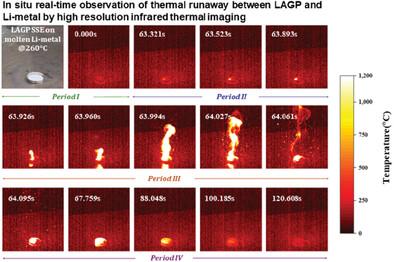Highly Safe All-Solid-State Lithium Metal Battery Enabled by Interface Thermal Runaway Regulation Between Lithium Metal and Solid-State Electrolyte
IF 18.5
1区 材料科学
Q1 CHEMISTRY, MULTIDISCIPLINARY
引用次数: 0
Abstract
All-solid-state (ASS) Li-metal batteries are regarded as promising energy-storage devices due to their high energy density and improved safety. Recently, the interface thermal runaway issues between reactive Li-metal and solid-state electrolytes (SSEs) have attracted increasing attention, but it has been less studied. Here, using in situ high-resolution thermal imaging, a significant stress-release period before the interface catches fire and burns between Li metal and Li1.5Al0.5Ge1.5(PO4)3 (LAGP) SSE is found that can provide opportunities for early thermal runaway warning for the batteries. Further, a highly safe ASS Li-metal battery without external pressure package is reported by constructing a stable heterogeneous interface layer (HIL) consisting of ALD-coated aluminum oxide and PECVD-deposited amorphous silicon (a-Si), which significantly reduces the interface exothermic reaction and suppresses the interface thermal runaway both theoretically and experimentally. The ASS Li-metal symmetric battery shows a long cycling stability both at RT and high temperature over 150 °C being at least 8-times higher than that of the one without HIL. The assembled Li-CO2 battery is capable of 100 stable cycles with <3.2 V low charge potential at 500 mAg−1 at 150 °C. This work paves a way for the development of the next-generation safe and high-energy lithium batteries.

求助全文
约1分钟内获得全文
求助全文
来源期刊

Advanced Functional Materials
工程技术-材料科学:综合
CiteScore
29.50
自引率
4.20%
发文量
2086
审稿时长
2.1 months
期刊介绍:
Firmly established as a top-tier materials science journal, Advanced Functional Materials reports breakthrough research in all aspects of materials science, including nanotechnology, chemistry, physics, and biology every week.
Advanced Functional Materials is known for its rapid and fair peer review, quality content, and high impact, making it the first choice of the international materials science community.
 求助内容:
求助内容: 应助结果提醒方式:
应助结果提醒方式:


